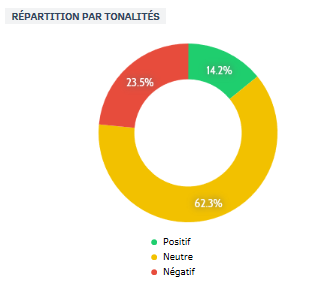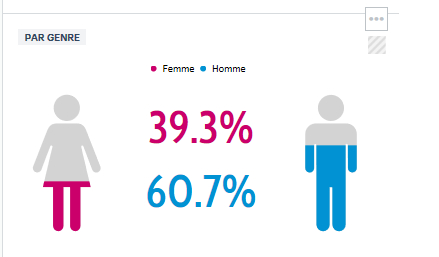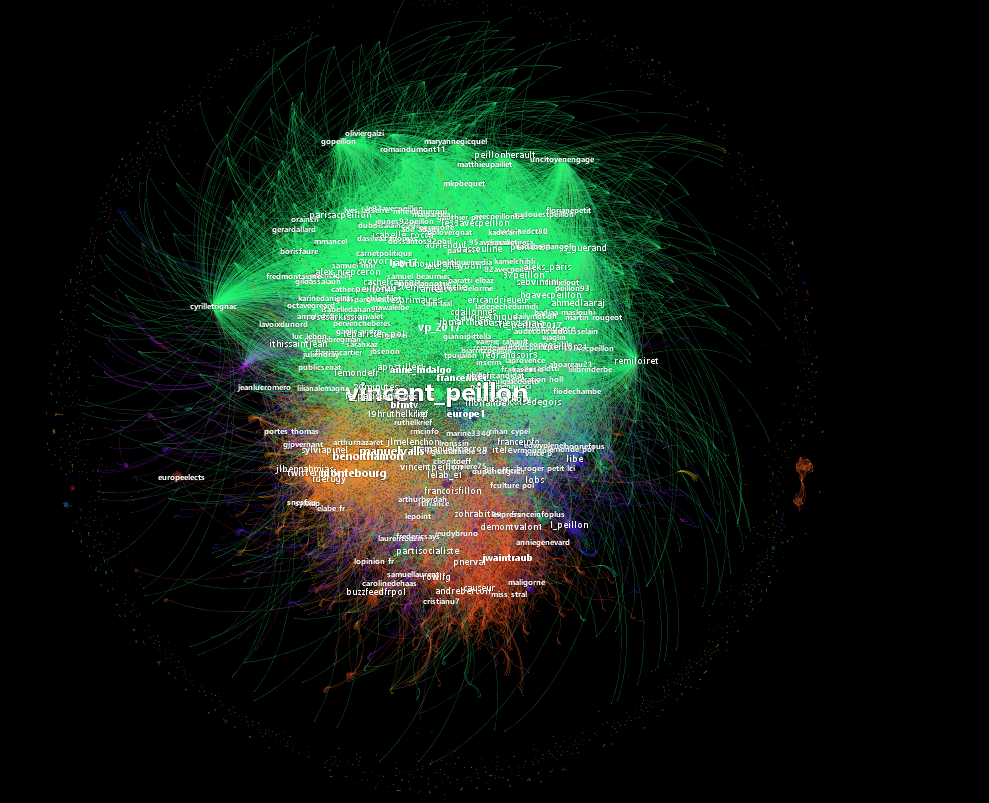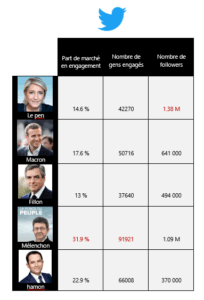Sommaire
If we listen to the social network indicators, Benoit Hamon is in the lead in the 1st round

Today sees the first round of the Citizens' Primary. An opportunity to take stock of this election based on data gleaned from social networks. To do this, I've brought together all the best software(Visibrain, Talkwalker and Brandwatch), and much of what is currently possible via social networks.
The main findings
1. If social networks were to vote: Hamon wins. Valls in ambush, Montebourg far behind
- Hamon would come first (best engagement on Twitter, best engagement rate among his rivals, best engagement on Facebook in terms of shares, likes and comments, best Facebook fan gain, best engagement rate among hyper fans on Facebook, best activation of activists on Twitter).
- Valls would be second(better with women, better rate of likes and comments/post on Facebook, better in the press and in newspaper headlines, better geographical spread of Twitter followers, almost on a par with Hamon in terms of activating activists on Twitter).
- Montebourg would come third(the only indicator that would put him in the second round would be his appearance in the press headlines!)
2. Primary debates run out of steam
In terms of the number of tweets, we can see that the primary debates are running out of steam. From 180,000 to 130,000 tweets, this suggests that holding no fewer than 3 debates in 1 week has caused people to run out of steam and gradually turn away from the debates.3. The patriosphere on Montebourg
Only one candidate has received bullying and frontal attacks from the patriosphere: Arnaud Montebourg. This shows that the patriosphere is aware of certain political axes that need to be isolated to ensure Marine Lepen's passage. There is no doubt that Montebourg, through his patriotic communication and his social position, is the Socialist Party candidate closest to Marine Lepen. There is therefore every chance that the rest of the presidential election will be similar, with attempts at destabilisation and attacks via social networks.4. Similarities and differences with the right-wing primary.
As a reminder, here I analysed the right-wing primary using the same indicators. There were some similarities:- A still male-dominated universe.
- Also, candidates who are totally absent from Twitter only reappear once the campaign is underway!
- Negativity always pays off.
- Conversations always follow a narrow crowd.
- Political sensibilities are somewhat less palpable between the different candidates. On the other hand, campaigners are still clearly identifiable through Social Network Analysis.
5. The first bot of the elections.
As I mentioned and demonstrated earlier this week, we've had our first bot of the election from the National Front. Fortunately, it's easy to identify via the mapping of conversations. (Like Valls' namesake!)6. A quick portrait of the candidates based on the Social Web
- Manuel Valls: A growing presence on Twitter, Manuel Valls has a good activist base, similar to Hamon, and extensive press coverage. Less active on Facebook than the others, each of his posts has the highest average number of likes. He is also very good with women and has the most scattered audience of all the candidates.
- Benoit Hamon: Benoit Hamon is the leader of the primary on social networks. He is the one who is most successful in capturing the audience of the other candidates, the one who has the most activists in terms of share of the vote for himself and a host of other indicators. He may be fishing for the female public and has not had as much press coverage as his main rivals.
- Arnaud Montebourg: compared with the polls, he achieved the lowest scores. Particularly weak with women, he is the only candidate to have suffered a few warning shots from the patriosphere. If he were to be in the second round, the only justifying indicator would be his presence in the headlines.
- Vincent Peillon: Peillon was more active on Twitter at the start of his campaign than during the debates. He didn't really emerge and most of the comments were about his remarks on the Second World War.
- François de Rugy: Despite a high rate of production on Facebook (in reality, he is relaying positive citizens towards him), engagement is at a low.
- Sylvia Pinel: Despite a small community of followers, she speaks out almost as rarely as she does in the debates.
- Jean-Luc Bennahmias: in view of the activity on social networks and the communities present to support him, one wonders whether his candidacy is serious.
Contents
I . Comparing the different social networks
II. General discussions on the primary III. Profiles of each candidate based on social networks- Manuel Valls
- Benoit Hamon
- Arnaud Montebourg
- Vincent Peillon
- François de Rugy
- Sylvia Pinel
- Jean-Luc Bennahmias
Methodology
I. Comparing the different social networks
1. Twitter
Back to summary
a) Agreement between followers
It can be read from horizontal to vertical:Example: 3.1% of Manuel Valls' followers also follow Benoit Hamon, while only 6.4% of Benoit Hamon's followers also follow Manuel Valls, etc.
 The lack of a shared audience between Valls and the others is rather strange since these figures were not observed for the left-wing primary. Peillon has the most correspondence with the smaller candidates.
The lack of a shared audience between Valls and the others is rather strange since these figures were not observed for the left-wing primary. Peillon has the most correspondence with the smaller candidates.b) Consistency between committed audiences
For this chapter, I have isolated between 21 December 2016 and 21 January 2017 the audiences that interacted with the different candidates in the Republican primary. It reads from horizontal to vertical:Example: 6.65% of people who interacted with Manuel Valls also interacted with Hamon, while 2.82% of those who interacted with Benoit Hamon, also did so with Manuel Valls, etc.
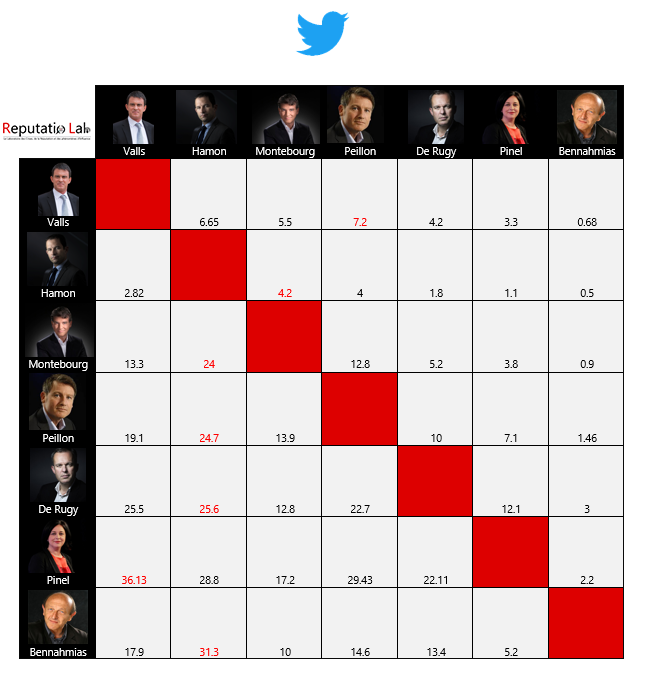 Benoit Hamon is the most successful at capturing the audience of others.
Benoit Hamon is the most successful at capturing the audience of others.c) Demographic analysis
1) Gender
 On Twitter, the majority of people who interact with politicians are men. Montebourg is the one who works least with women.
On Twitter, the majority of people who interact with politicians are men. Montebourg is the one who works least with women.2) Location
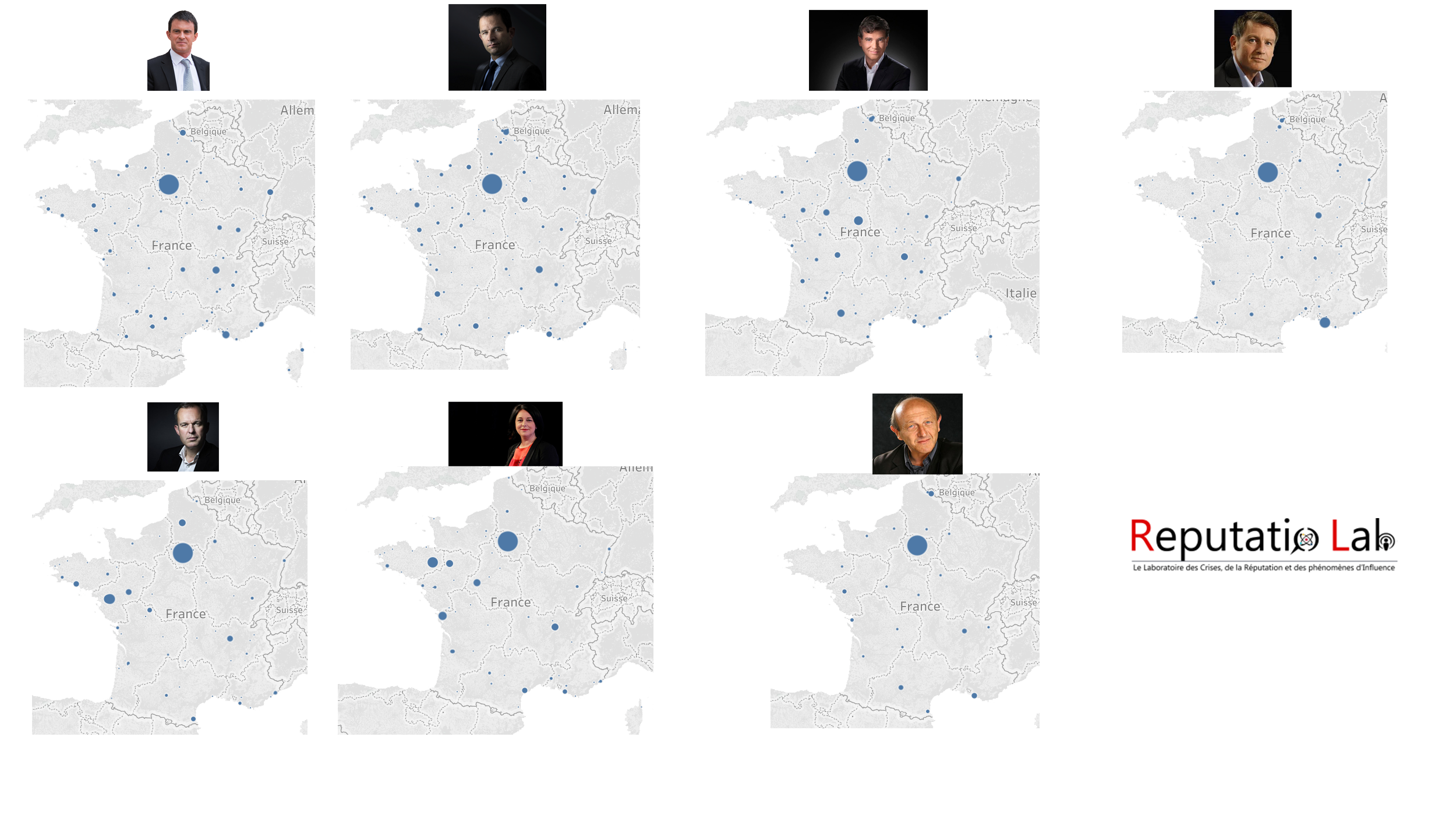
Before any analysis, we need to make one clarification: the size of the points is proportional and therefore cannot be compared between candidates.
The only candidate with a total presence is Manuel Valls. Hamon has a greater presence in the North than the others, while Montebourg has a presence in the West.
2. Facebook
Back to summarya) Agreement between the 100 most active users
No monitoring platform currently allows you to obtain more than 100 users of a Facebook page. So I had to make a comparison based on the 100 most active Facebook users of the 4 main primary candidates. Here again, it's Hamon who gleans the most from the others!
Here again, it's Hamon who gleans the most from the others!B) Demographics
On Facebook, it is not possible to isolate users geographically, but it is possible to break down the genders of those who have interacted. On Facebook, De Rugy is ahead of Montebourg for those who attract the fewest female users. Valls remains the candidate with the most female interaction.
On Facebook, De Rugy is ahead of Montebourg for those who attract the fewest female users. Valls remains the candidate with the most female interaction.3. In the press
Back to summaryThe breakdown of press titles is as follows: Valls wins by a wide margin, and this is not just due to a single news item (the slap), even if it does have an impact, since the gap is constant over the month. Moreover, even in the body of the texts, he is more present:
Valls wins by a wide margin, and this is not just due to a single news item (the slap), even if it does have an impact, since the gap is constant over the month. Moreover, even in the body of the texts, he is more present:
II. General discussions on the primary
Back to summary
1. In general
 2.4 million tweets in one month, whereas the right-wing primary attracted more than 18 million tweets in 4 months. Clearly, the volume is in no way comparable.
2.4 million tweets in one month, whereas the right-wing primary attracted more than 18 million tweets in 4 months. Clearly, the volume is in no way comparable. Geographically, as for the right, we interact in the metropolises:
Geographically, as for the right, we interact in the metropolises: It also affects far more men than women:
It also affects far more men than women: In terms of the most popular sites, Instagram was not used at all, unlike the right. Le Monde also came ahead of Le Figaro.
In terms of the most popular sites, Instagram was not used at all, unlike the right. Le Monde also came ahead of Le Figaro.
2. The primary debates
Back to summary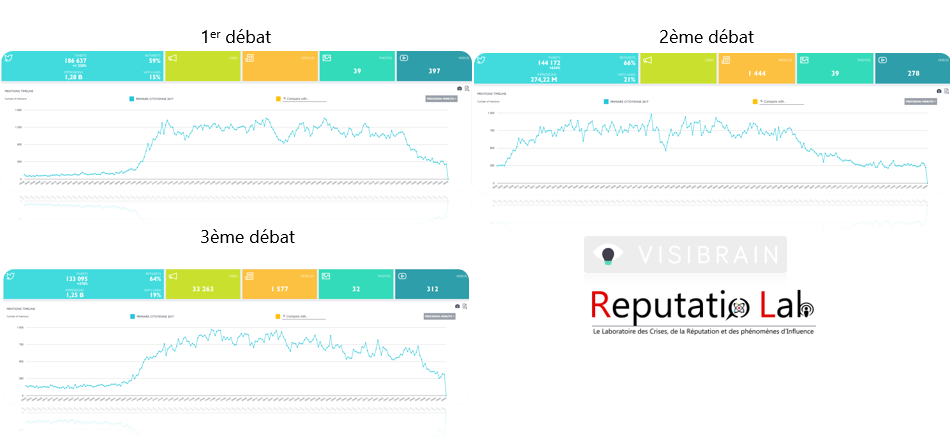 The primary debates generated between 130,000 and 180,000 tweets. This figure shows that the Twittos are running out of steam, as the number has fallen steadily after each debate. It has to be said that imposing 3 debates in 7 days was enough to make people weary.
The primary debates generated between 130,000 and 180,000 tweets. This figure shows that the Twittos are running out of steam, as the number has fallen steadily after each debate. It has to be said that imposing 3 debates in 7 days was enough to make people weary.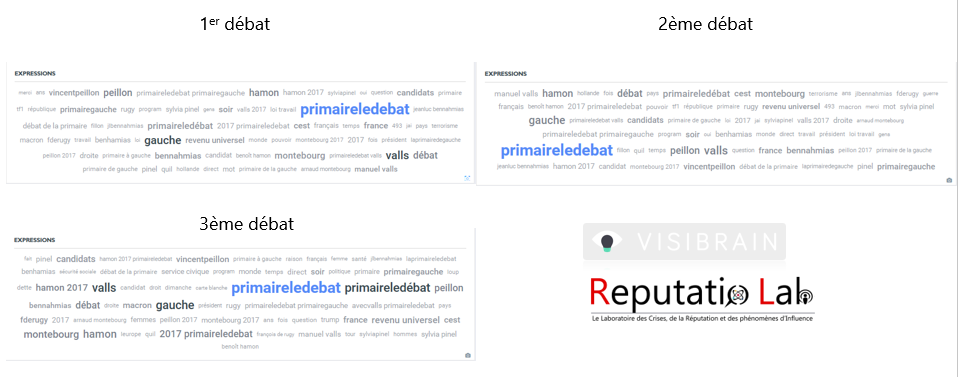 Overall, there was no change in the most tweeted words in the various debates (without weighting tweets by retweets).
Overall, there was no change in the most tweeted words in the various debates (without weighting tweets by retweets).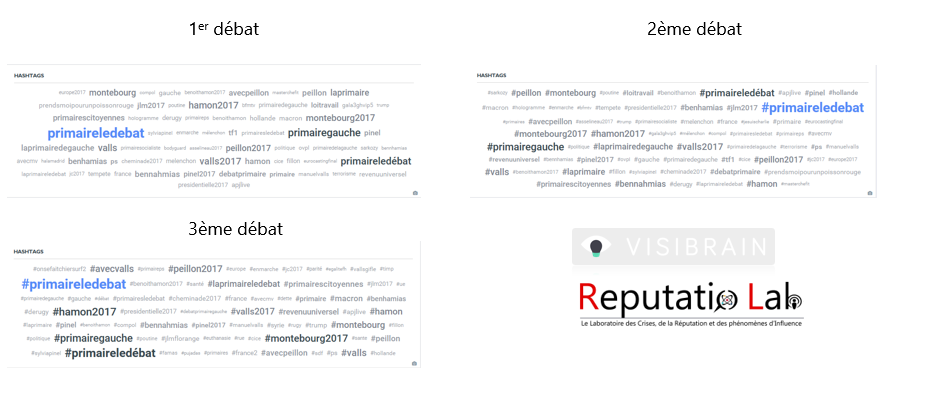
To see the maps in full size, please click on them.
During the first debate, we had a fairly dense set with each candidate on his own side: (Filter with 2 interactions) For the second (unfiltered), we still had a dense crowd with Benoit Hamon, but because of tweets that resurfaced :
For the second (unfiltered), we still had a dense crowd with Benoit Hamon, but because of tweets that resurfaced : The breakdown of communities was therefore: - Hamon - 13.05% - Valls - 6.28% - Montebourg 5.75% - Peillon 4.88%. For the third, the same conclusion:
The breakdown of communities was therefore: - Hamon - 13.05% - Valls - 6.28% - Montebourg 5.75% - Peillon 4.88%. For the third, the same conclusion: (- Valls: 7.92% - Hamon: 7.56% - Montebourg: 5.91% - Peillon: 4.22%)
(- Valls: 7.92% - Hamon: 7.56% - Montebourg: 5.91% - Peillon: 4.22%)III. Profiles of each candidate based on social networks
1. Manuel Valls
Back to summarya) his digital portrait on Twitter
 Manuel Valls maintained a constant presence, with obvious peaks towards the end of the primary. However, he was not very active compared to the others. His hashtags are essentially slogans or themes:
Manuel Valls maintained a constant presence, with obvious peaks towards the end of the primary. However, he was not very active compared to the others. His hashtags are essentially slogans or themes: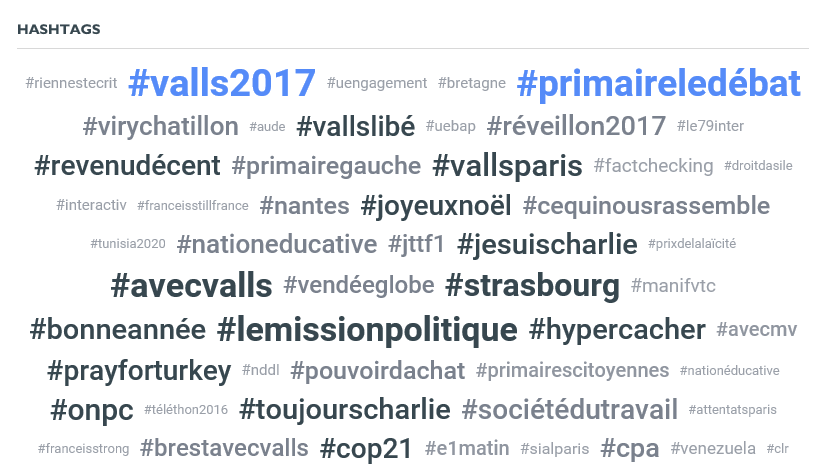 His expressions are a bit all over the place:
His expressions are a bit all over the place: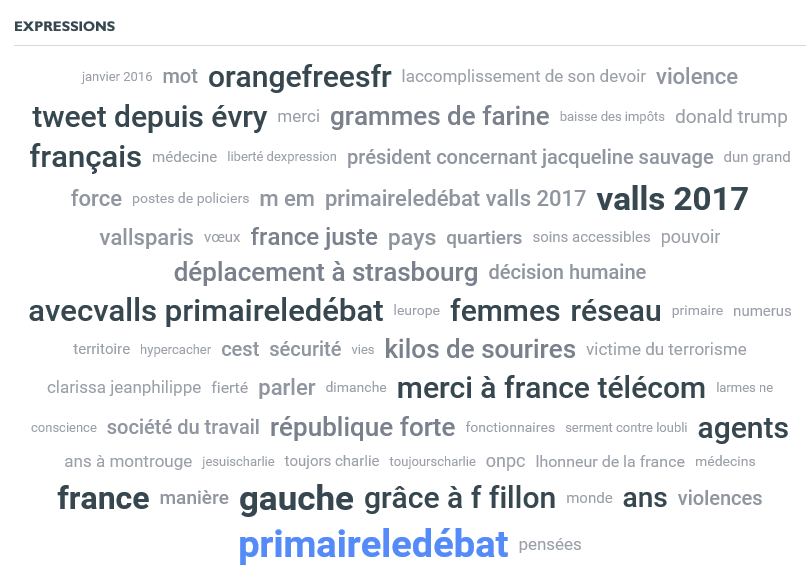
b) His audience
 Valls has a presence throughout the country. But it's in Paris that there are the most tweets.
Valls has a presence throughout the country. But it's in Paris that there are the most tweets.
c) What Twitter has to say
 This is the slap that got the most people talking on Twitter. In fact, it's one of the top tweets:
This is the slap that got the most people talking on Twitter. In fact, it's one of the top tweets:
4) The Web
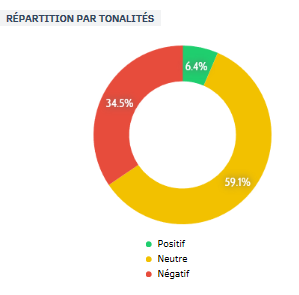

2. Benoit Hamon
Back to summarya) his digital portrait on Twitter
 Hamon's presence was essentially concentrated around the debates. So it's no surprise that it's the debate hashtags that stand out.
Hamon's presence was essentially concentrated around the debates. So it's no surprise that it's the debate hashtags that stand out. His expressions are on social protection, voluntary work and universal income:
His expressions are on social protection, voluntary work and universal income:
b) Its audience
 Amont operates mainly in Paris. And its audience is mainly male:
Amont operates mainly in Paris. And its audience is mainly male:

c) What Twitter has to say
What Twitter has to say about it is pretty much what it says about itself: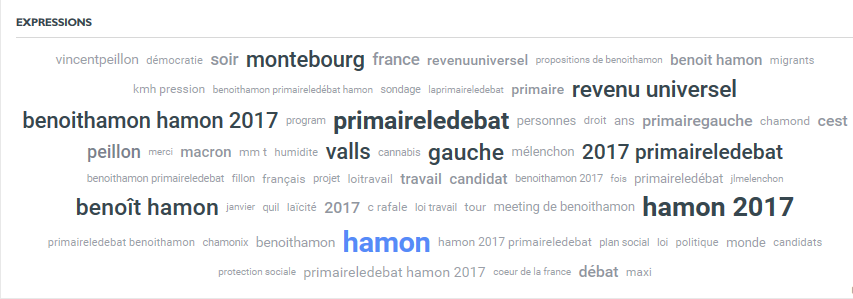 On the other hand, the top tweet is entirely filled with his old tweets!
On the other hand, the top tweet is entirely filled with his old tweets!
4) The Web


3. Arnaud Montebourg
Back to table of contentsa) his digital portrait on Twitter
 Montebourg's presence was also essentially concentrated around the debates. However, it was his slogan that he used the most. The reference to Jaures is also noteworthy
Montebourg's presence was also essentially concentrated around the debates. However, it was his slogan that he used the most. The reference to Jaures is also noteworthy His expressions do not have very clear axes
His expressions do not have very clear axes
b) Its audience
 Montebourg is mainly present in Paris, although there is a strong presence in the centre. His audience is very male:
Montebourg is mainly present in Paris, although there is a strong presence in the centre. His audience is very male:

c) What Twitter has to say
Montebourg without the retweets and according to users, it's mainly the scandal surrounding the founder of terra nova accused of paedophilia: This is also reflected in the top retweets:
This is also reflected in the top retweets: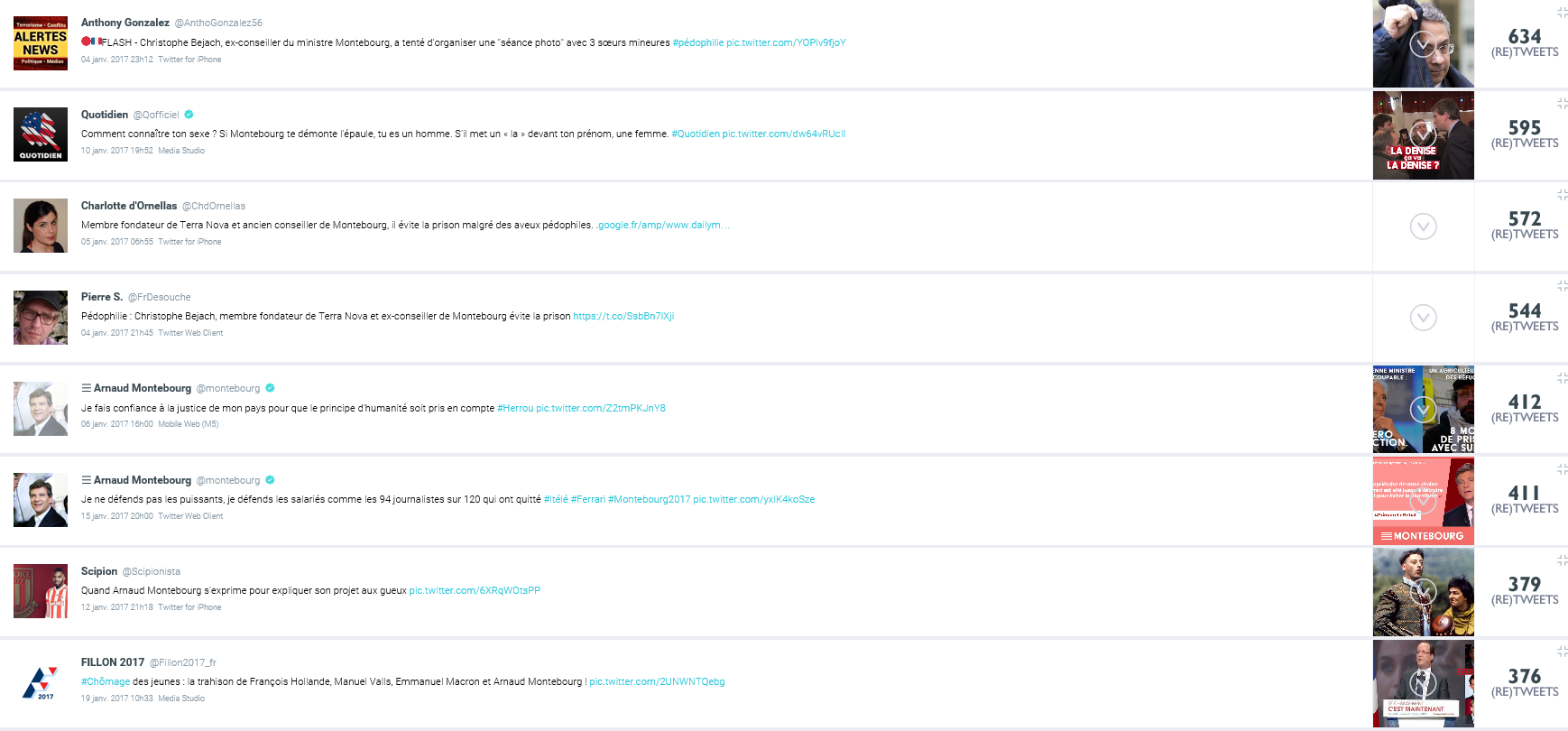
4) The Web


4. Vincent Peillon
Back to table of contentsa) his digital portrait on Twitter
 Peillon is measured in his activity. His campaigning is more active than the debates. In hashtags, slogans and debates are the most used.
Peillon is measured in his activity. His campaigning is more active than the debates. In hashtags, slogans and debates are the most used. His expressions illustrate all the themes:
His expressions illustrate all the themes:
b) Its audience
 Peillon operates mainly in Paris and the south-east. Its audience is male:
Peillon operates mainly in Paris and the south-east. Its audience is male:
c) What Twitter has to say
What Twitter is saying is related to his statement on Jews under Vichy. : Same thing for top tweets: (The previous graph does not include RTs)
Same thing for top tweets: (The previous graph does not include RTs)
4) The Web

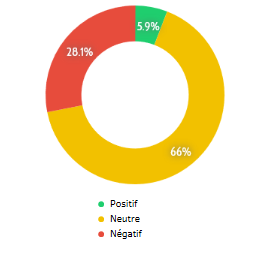
5. François de Rugy
a) his digital portrait on Twitter
 The same goes for the expressions, which cover more or less all the themes:
The same goes for the expressions, which cover more or less all the themes:
b) Your audience
 Peillon operates mainly in Paris and the north-west. Its audience is male:
Peillon operates mainly in Paris and the north-west. Its audience is male:

c) What Twitter has to say
What Twitter is saying is essentially about feminism and other debates: Same thing in the top tweets: (The previous graph does not include RTs)
Same thing in the top tweets: (The previous graph does not include RTs)
4) The Web


6. Sylvia Pinel
Back to table of contentsa) his digital portrait on Twitter
 In the expressions, there's a lot of activity too:
In the expressions, there's a lot of activity too:
b) Its audience
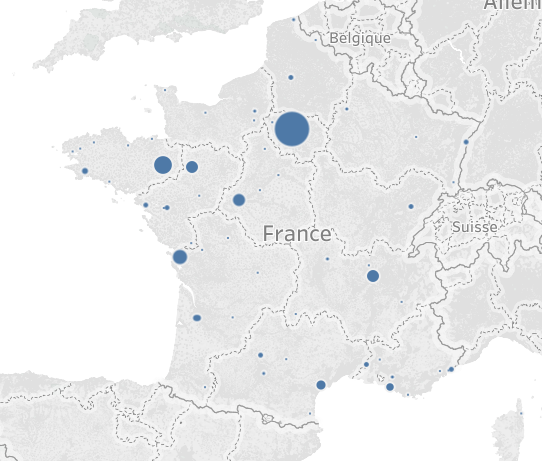 Her audience is in Paris or the north-west of France. She does less well than Valls with women:
Her audience is in Paris or the north-west of France. She does less well than Valls with women: 

c) What Twitter has to say
What Twitter is saying is essentially about cannabis. The top tweet is not very positive:
The top tweet is not very positive: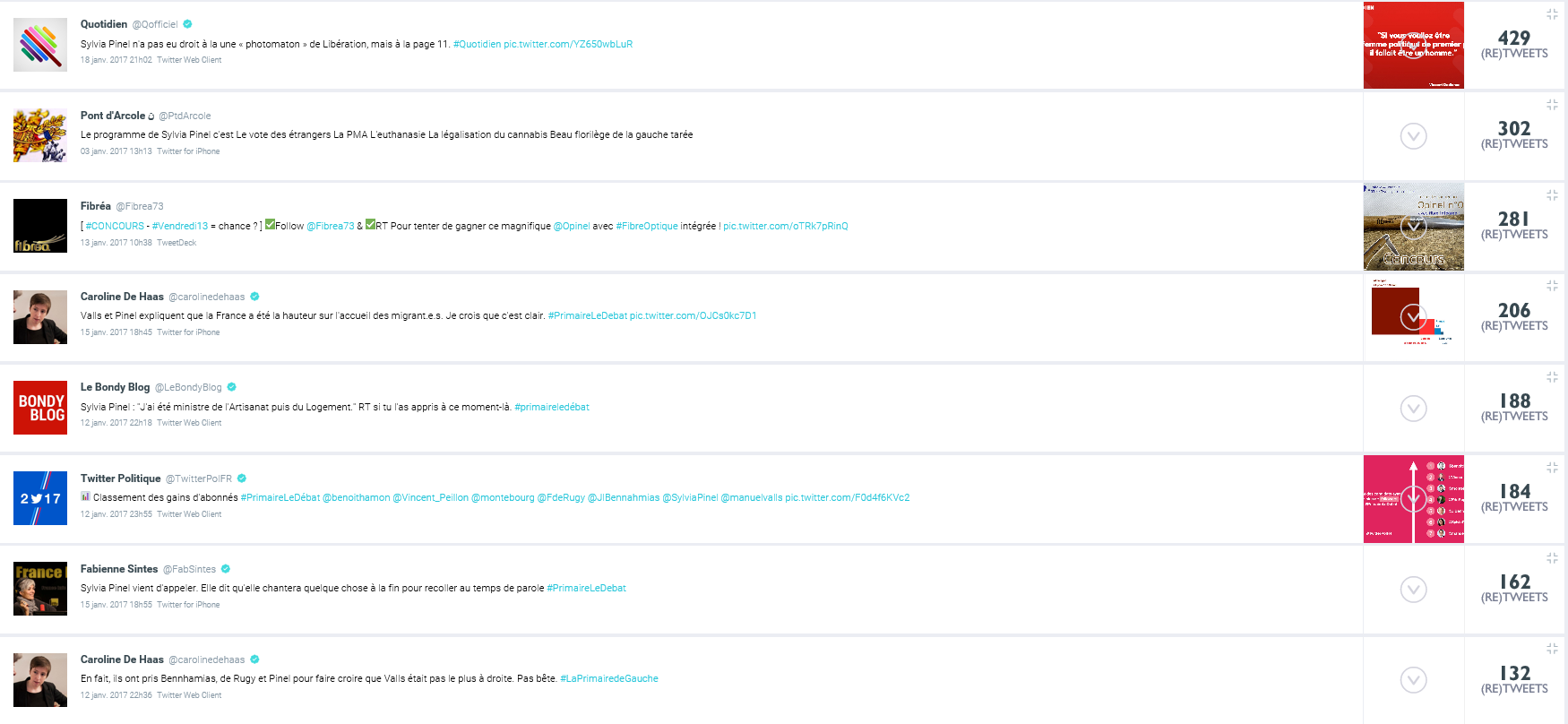
4) The Web
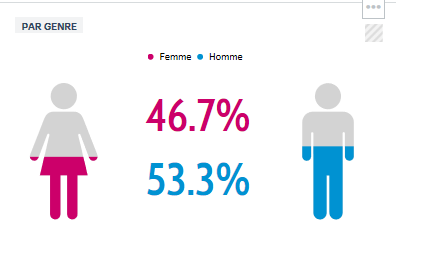

7. Jean-Luc Bennahmias
Back to table of contentsa) his digital portrait on Twitter
 As Bennahmias only retweets, his Twitter activity is almost non-existent.
As Bennahmias only retweets, his Twitter activity is almost non-existent. On the Pinel side, the activity curve is quite staggering: even during the first debate, there was nothing. In hashtags, too, it's a total knockout:In the expressions, there's a lot going on too
On the Pinel side, the activity curve is quite staggering: even during the first debate, there was nothing. In hashtags, too, it's a total knockout:In the expressions, there's a lot going on toob) His audience
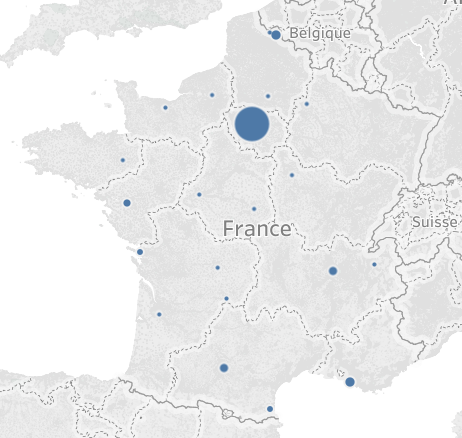 Its audience is in Paris and is very male:
Its audience is in Paris and is very male:
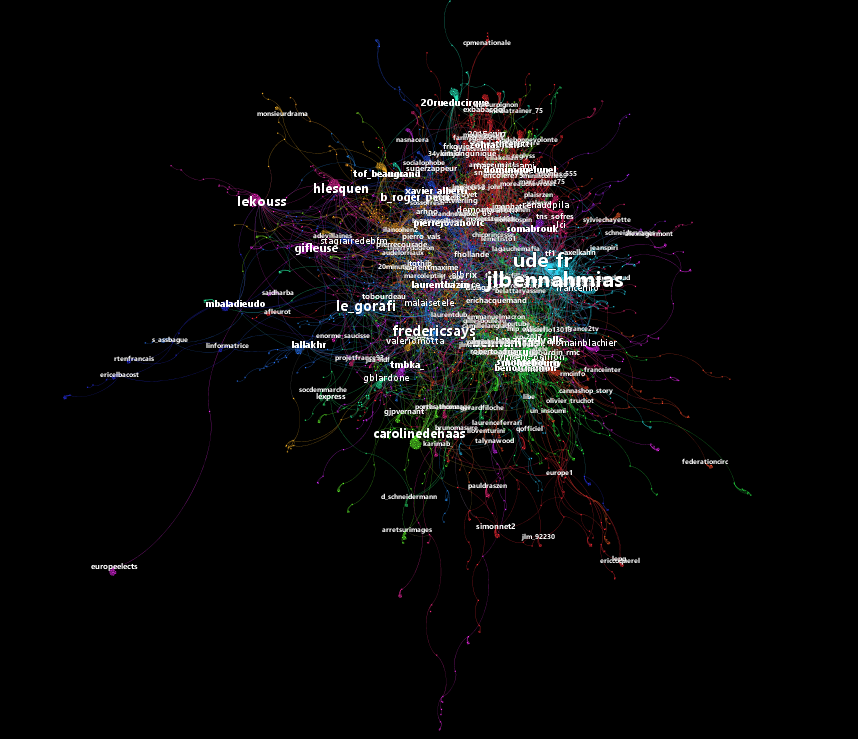
c) What Twitter has to say
Not really much in its expressions: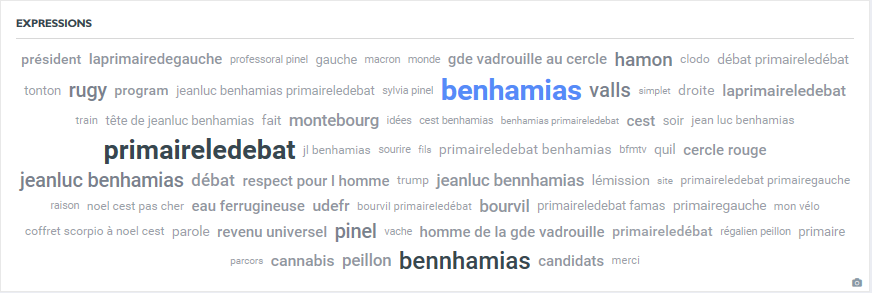 For Le top tweet, it's mostly mockery:
For Le top tweet, it's mostly mockery: 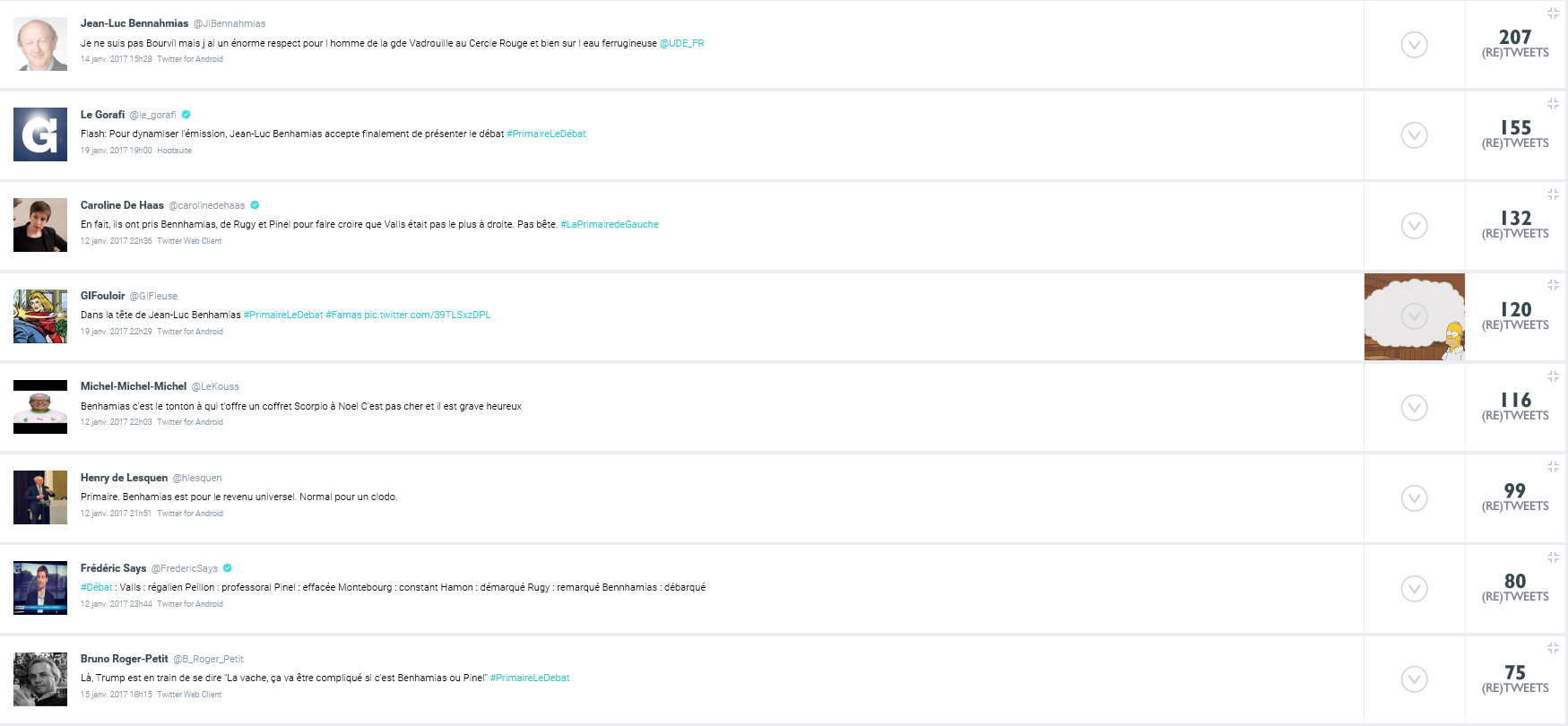
4) The Web
